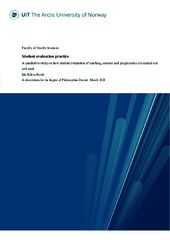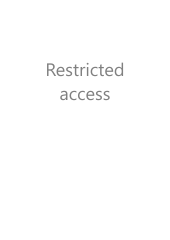| dc.contributor.advisor | Sandvoll, Ragnhild | |
| dc.contributor.author | Borch, Iris Helene | |
| dc.date.accessioned | 2021-08-04T09:37:46Z | |
| dc.date.available | 2021-08-04T09:37:46Z | |
| dc.date.embargoEndDate | 2026-08-27 | |
| dc.date.issued | 2021-08-27 | |
| dc.description.abstract | This study explores how internal student evaluation of teaching, courses and programmes at eight health profession education programmes are carried out and used. Student evaluation is a mandatory part of quality assurance systems in Norway and is meant to be used in educational quality assurance and enhancement. At the university of this study, these evaluations are also considered part of students’ learning processes and student empowerment. The study investigates pedagogical and organisational dimensions to evaluation practice, including how different actors interact in evaluation processes and how the interplay between policy and practice are balanced. The study has an exploratory qualitative research design and comprises different research methods: semi-structured interviews with academics, focus group interviews with students and document analysis of internal evaluation documents. The study reveals that organisational and pedagogical dimensions of evaluation practice seem to affect how evaluation is carried out and limit use of evaluation for enhancement purposes. A noteworthy gap is revealed between intended use and practice articulated in the local quality assurance system, and the actual use described by the academics and students. Evaluation practice is decoupled from the evaluation guidelines and the quality assurance system. The system is developed and communicated by administrative staff on behalf of the university management with an expectation that academics will follow the system guidelines. The academics are not familiar with details in the system and are left to themselves in evaluation practice but they still make sure evaluation is carried out. However, they request more support and knowledge about evaluation. Student evaluations seemed to be better suited for quality assurance than quality enhancement. A framework for a student-learning-centred evaluation practice is developed based upon the findings. In this framework student evaluation is integrated in constructive alignment wherein a student learning perspective is central. The framework can be used as support for universities that want to strengthen the learning focus in evaluation practice. | en_US |
| dc.description.doctoraltype | ph.d. | en_US |
| dc.description.popularabstract | Student evaluation is mandatory in Norwegian higher education and is meant to be used in quality assurance and enhancement. This study investigates pedagogical and organisational dimensions of current evaluation practice to better understand how evaluation is carried out and used. The study comprises semi-structured interviews with academics, focus group interviews with students, and document analysis. The study reveals that organisational and pedagogical dimensions of evaluation practice limit use for improvement purposes. A noteworthy gap is revealed between intended use and practice articulated in the quality assurance system, and the actual use described by the academics and students. Student evaluations seem to be structured towards quality assurance rather than quality enhancement. A guiding framework for a more student-learning-centred evaluation practice is developed for universities that want to strengthen educational enhancement and learning focus in evaluation practice. | en_US |
| dc.description.sponsorship | UiT the Arctic University of Norway | en_US |
| dc.identifier.uri | https://hdl.handle.net/10037/21920 | |
| dc.language.iso | eng | en_US |
| dc.publisher | UiT The Arctic University of Norway | en_US |
| dc.publisher | UiT Norges arktiske universitet | en_US |
| dc.relation.haspart | <p>Paper 1: Borch, I., Sandvoll, R. & Risør, T. (2020). Discrepancies in Purposes of Student Course Evaluations: What Does It Mean to Be “Satisfied”? <i>Educational Assessment, Evaluation and Accountability, 32</i>(1), 83-102. Also available in Munin at <a href=https://hdl.handle.net/10037/17937>https://hdl.handle.net/10037/17937</a>.
<p>Paper 2: Borch, I. (2020). Lost in Translation: From the University’s Quality Assurance System to Student Evaluation Practice. <i>Nordic Journal of Studies in Educational Policy, 6</i>(3), 231–244. Also available in Munin at <a href=https://hdl.handle.net/10037/19951>https://hdl.handle.net/10037/19951</a>.
<p>Paper 3: Borch, I., Sandvoll, R. & Risør, T. (2021). Student Course Evaluation Documents: Constituting Evaluation Practice. <i>Assessment & Evaluation in Higher Education</i>. Published version not available in Munin due to publisher’s restrictions. Published version available at <a href=https://doi.org/10.1080/02602938.2021.1899130> https://doi.org/10.1080/02602938.2021.1899130</a>. Accepted manuscript version available in Munin at <a href=https://hdl.handle.net/10037/22741>https://hdl.handle.net/10037/22741</a>. | en_US |
| dc.rights.accessRights | embargoedAccess | en_US |
| dc.rights.holder | Copyright 2021 The Author(s) | |
| dc.rights.uri | https://creativecommons.org/licenses/by-nc-sa/4.0 | en_US |
| dc.rights | Attribution-NonCommercial-ShareAlike 4.0 International (CC BY-NC-SA 4.0) | en_US |
| dc.subject | Student evaluation practice | en_US |
| dc.subject | Evaluation use | en_US |
| dc.subject | Academics' perspectives | en_US |
| dc.subject | Students' perspectives | en_US |
| dc.subject | Student evaluation | en_US |
| dc.subject | Evaluation documents | en_US |
| dc.subject | Academic development | en_US |
| dc.subject | Educational quality | en_US |
| dc.title | Student evaluation practice: A qualitative study on how student evaluation of teaching, courses and programmes are carried out and used | en_US |
| dc.type | Doctoral thesis | en_US |
| dc.type | Doktorgradsavhandling | en_US |


 English
English norsk
norsk




